项目管理中的环境因素
项目环境分析

项目环境分析项目环境分析是项目管理中的重要一环,通过对项目所处的外部和内部环境进行分析,可以帮助项目团队更好地了解项目所面临的各种因素和挑战,从而有针对性地制定合适的计划和策略。
本文将从外部环境和内部环境两个方面进行项目环境分析。
一、外部环境分析外部环境是指项目所处的宏观环境,包括社会、经济、政治、技术和市场等方面的因素。
对项目的外部环境进行分析,可以帮助项目团队了解项目所在行业的发展趋势、市场竞争情况和政策环境等。
1. 社会环境分析社会环境是指项目所处的社会背景和社会发展状况。
在进行社会环境分析时,项目团队可以了解项目涉及的相关群体、他们的需求和期望,以及项目对社会的影响等因素。
例如,如果项目是一个社区建设项目,那么项目团队需要了解当地社区居民对建设项目的意见和反馈。
2. 经济环境分析经济环境是指项目所处的经济形势和市场状况。
进行经济环境分析时,项目团队可以了解项目所在地区的经济发展水平、市场竞争情况、投资环境等因素。
例如,如果项目是一个新产品的开发项目,那么项目团队需要了解目标市场的消费能力和需求情况,以便制定合适的营销策略。
3. 政治环境分析政治环境是指项目所处的政府政策和法规环境。
进行政治环境分析时,项目团队需要了解相关政府政策对项目的影响,以及项目在政府层面的支持和合规要求等方面的因素。
例如,如果项目是一个基础设施建设项目,那么项目团队需要了解相关政府部门的政策支持和审批程序。
4. 技术环境分析技术环境是指项目所处的技术水平和技术发展趋势。
进行技术环境分析时,项目团队可以了解相关技术的创新方向和应用前景,以及项目所需的技术资源和技术支持等因素。
例如,如果项目是一个软件开发项目,那么项目团队需要了解当前的软件开发技术和相关的工具和平台。
二、内部环境分析内部环境是指项目所处的组织内部的情况和条件。
对项目的内部环境进行分析,可以帮助项目团队了解项目团队的组成和能力、项目资源的分配和利用情况,以及项目管理和沟通等方面的情况。
项目环境的影响因素
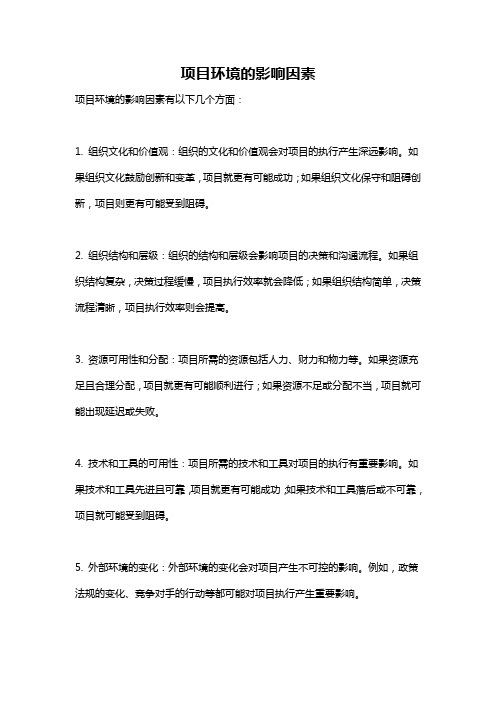
项目环境的影响因素
项目环境的影响因素有以下几个方面:
1. 组织文化和价值观:组织的文化和价值观会对项目的执行产生深远影响。
如果组织文化鼓励创新和变革,项目就更有可能成功;如果组织文化保守和阻碍创新,项目则更有可能受到阻碍。
2. 组织结构和层级:组织的结构和层级会影响项目的决策和沟通流程。
如果组织结构复杂,决策过程缓慢,项目执行效率就会降低;如果组织结构简单,决策流程清晰,项目执行效率则会提高。
3. 资源可用性和分配:项目所需的资源包括人力、财力和物力等。
如果资源充足且合理分配,项目就更有可能顺利进行;如果资源不足或分配不当,项目就可能出现延迟或失败。
4. 技术和工具的可用性:项目所需的技术和工具对项目的执行有重要影响。
如果技术和工具先进且可靠,项目就更有可能成功;如果技术和工具落后或不可靠,项目就可能受到阻碍。
5. 外部环境的变化:外部环境的变化会对项目产生不可控的影响。
例如,政策法规的变化、竞争对手的行动等都可能对项目执行产生重要影响。
6. 利益相关方的影响:利益相关方包括项目发起人、项目经理、团队成员、客户、供应商等。
他们的期望、利益和行为会对项目的执行产生影响。
如果利益相关方支持项目并积极参与,项目就更有可能成功;如果利益相关方不支持或阻碍项目,项目就可能受到影响。
环境因素管理要点总结

环境因素管理要点总结1. 简介环境因素管理是项目管理中一个重要的方面,它涵盖了项目所处的外部环境和内部环境对项目目标的影响。
项目环境因素包括组织文化、组织结构、市场竞争、行业标准等,对项目的计划、风险、资源等方面都有直接或间接的影响。
在项目管理中,合理地管理环境因素能够提高项目成功的可能性,避免项目失败的风险。
2. 环境因素管理的重要性环境因素管理对项目管理的重要性体现在以下几个方面:2.1 影响项目计划环境因素会直接或间接地影响项目计划的制定和执行。
例如,市场竞争激烈的行业可能会导致项目时间紧迫、成本增加;行业标准的变化可能导致项目需要调整计划,甚至需要重新设计和开发。
因此,项目经理需要及时地了解和分析环境因素,合理地制定项目计划。
2.2 可能引发项目风险环境因素对项目风险的影响是巨大的。
行业发展不稳定、经济周期波动、政策法规的变化等都可能对项目的顺利进行带来风险。
项目经理需要通过有效的环境因素管理来识别、评估和规划项目风险,从而降低项目失败的风险。
2.3 影响项目资源项目所处的环境因素会对项目资源的供给和使用产生影响。
例如,行业竞争激烈可能导致人才的流动性增加,项目经理需要采取措施来保留和吸引关键人才;经济形势的不稳定可能导致资金的短缺,项目经理需要合理规划项目预算,确保资源的有效使用。
3. 环境因素管理要点在管理环境因素时,项目经理需要注意以下要点:3.1 了解环境因素项目经理需要对项目所处的外部环境和内部环境有清晰的了解。
这包括了解行业的发展趋势、市场的需求变化、关键利益相关方的态度等。
通过持续的市场调研和与利益相关方的沟通交流,项目经理能够更好地把握环境因素的动向,做出相应的决策。
3.2 建立良好的沟通渠道沟通是项目管理中至关重要的一环,也是管理环境因素的重要手段。
项目经理需要与组织内外的利益相关方建立良好的沟通渠道,及时了解外部环境的变化和内部环境的情况。
通过定期与相关方进行沟通会议、项目报告的撰写和发布等方式,项目经理能够传递项目信息,促进项目与环境的有效融合。
环境因素对工期的影响及其应对措施

环境因素对工期的影响及其应对措施环境因素是指影响项目工期的外部因素,包括自然环境、社会环境、经济环境等。
这些因素对工期的影响可以是正面的,也可以是负面的。
有效地应对环境因素对工期的影响是项目管理的重要任务之一、下面将就环境因素对工期的影响及其应对措施展开论述。
1.天气因素:天气的不确定性会对项目工期产生很大影响,如恶劣的天气可能导致施工暂停或延误。
在面临天气不确定的情况下,可以通过制定应急预案、合理安排工序等方式来应对。
同时,可以通过预先检查天气预报来提前做好调整和准备工作。
2.地质环境因素:地质环境是指土地、浅层地下土壤岩石的性质以及地下水情况。
地质环境的不确定性会给工期带来很大的风险,如地基处理可能需要更多时间。
应对地质环境因素,可以通过提前进行勘察,合理选择工地和适当的地基处理方式,以减少对工期的影响。
3.环境保护因素:在施工过程中,需要遵守环境保护法规,如噪音、粉尘等污染的控制和处理。
如果环境保护问题没有得到很好的解决,可能会导致工期的延误。
应对环境保护因素,应积极与相关部门沟通,制定并执行环境保护计划,确保施工在合规的环境下进行。
1.劳动力供给:社会环境中劳动力供给的变化会对工期产生很大的影响,如人力资源短缺、劳动力成本上升等。
在劳动力不足的情况下,可以通过技术改进、使用机械化设备等方式来提高工作效率,以减少对工期的影响。
2.法律法规:社会环境中的法律法规对项目建设有着严格的限制和要求。
如果项目不符合相关法律法规的要求,可能会导致工期的延误。
解决这一问题的方法包括:加强对相关法律法规的学习和理解,制定配套管理措施,确保项目的合法性和合规性。
3.社会风险:社会环境中的安全风险、社会安全活动、金融市场波动等都有可能对工期产生重大的影响。
在面临这些风险时,应制定相关风险评估和应对方案,加强监管和安全控制,确保项目能够在稳定和安全的环境下进行。
1.经济周期:宏观经济环境的变化会对项目工期产生重要影响。
环境因素清单
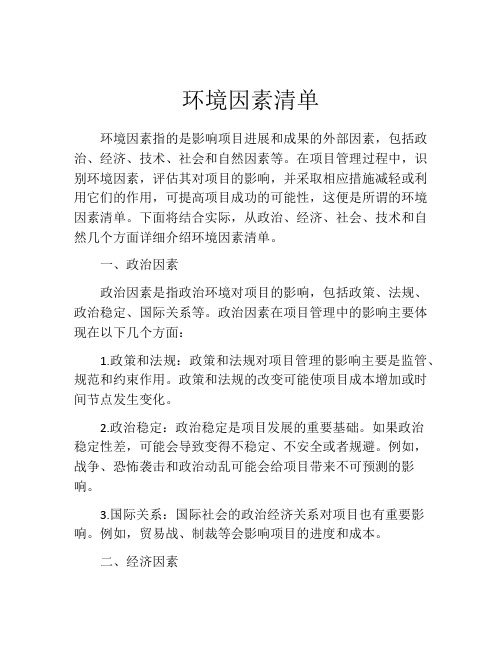
环境因素清单环境因素指的是影响项目进展和成果的外部因素,包括政治、经济、技术、社会和自然因素等。
在项目管理过程中,识别环境因素,评估其对项目的影响,并采取相应措施减轻或利用它们的作用,可提高项目成功的可能性,这便是所谓的环境因素清单。
下面将结合实际,从政治、经济、社会、技术和自然几个方面详细介绍环境因素清单。
一、政治因素政治因素是指政治环境对项目的影响,包括政策、法规、政治稳定、国际关系等。
政治因素在项目管理中的影响主要体现在以下几个方面:1.政策和法规:政策和法规对项目管理的影响主要是监管、规范和约束作用。
政策和法规的改变可能使项目成本增加或时间节点发生变化。
2.政治稳定:政治稳定是项目发展的重要基础。
如果政治稳定性差,可能会导致变得不稳定、不安全或者规避。
例如,战争、恐怖袭击和政治动乱可能会给项目带来不可预测的影响。
3.国际关系:国际社会的政治经济关系对项目也有重要影响。
例如,贸易战、制裁等会影响项目的进度和成本。
二、经济因素经济因素是指宏观经济环境对项目的影响,主要包括货币政策、财政政策、市场环境等。
经济因素在项目管理中的影响主要体现在以下几个方面:1.投资环境:投资环境是项目的基础,不良的投资环境会导致资金难以获取或者资金成本过高。
2.市场环境:市场供求关系、价格波动均会影响项目执行。
尤其是企业市场竞争环境,或整个产业的市场环境发生改变,均极大地影响项目发展。
3.财务情况:财务情况直接关系到项目决策、实施、监控以及最终收益。
如果企业财务情况不佳,会影响项目的资金投入。
三、社会因素社会因素通常指的是社会文化环境、社会经济环境对项目的影响。
社会因素在项目管理中的影响主要体现在以下几个方面:1.人口因素:人口结构、劳动力市场、文化素质等因素会直接影响到项目的实施和成功,比如不同文化背景和教育程度的员工,对方案的理解和执行力度不尽相同。
2.传统风俗:传统风俗因素可能影响到某些项目的执行。
如,某地的文化禁忌会对卫生防疫、考古挖掘等项目的实施带来阻力。
(项目管理)项目汇总环境因素清单
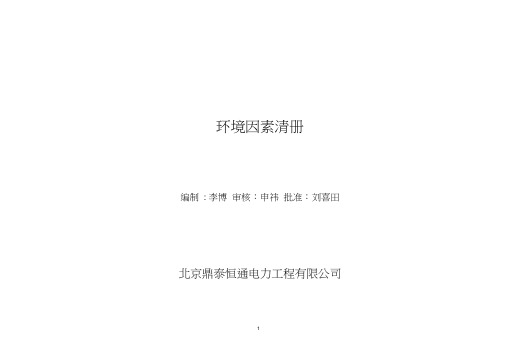
正常
121
翻斗车尾气的排放
大气污染
正常
122
运输粉尘的排放
大气污染
正常
123
面砖切割机噪声排放
影响周边居民工作、
休息
正常
124
外墙面砖工程
碎砖的丢弃
土壤污染
正常
125
包装纸盒的废弃
土壤污染
正常
126
浸砖水的排放
水污染
正常
序号
作业活动
环境因素
环境影响
时态/状态
评价结果
控制方式
127
修补作业砂浆废料的废弃
正常
76
塑料胶带的废弃
土壤污染
正常
77
混凝土工程
商品混凝土运输遗洒
土壤污染
异常
78
运输尾气排放
大气污染
正常
序号
作业活动
环境因素
环境影响
时态/状态
评价结果
控制方式
79
运输车辆噪声的排放
影响周边居民工作、
休息
正常
80
现场路面的粉尘
大气污染
正常
81
施工中混凝土遗洒
土壤污染
正常
82
混凝土养护剂气味的排放
大气污染
评价结果
控制方式
53
氧气瓶、乙炔瓶库房及作业面发生火 灾、爆炸
大气污染
将来/紧急
54
乙炔发生罐污水排放
水污染
正常
55
钢筋切割时废渣散落废弃
土壤污染
正常
56
钢筋工程
钢筋焊接产生的废渣废弃
土壤污染
正常
57
钢筋除锈用铁刷废弃
环境因素识别评价及控制措施表(项目部)
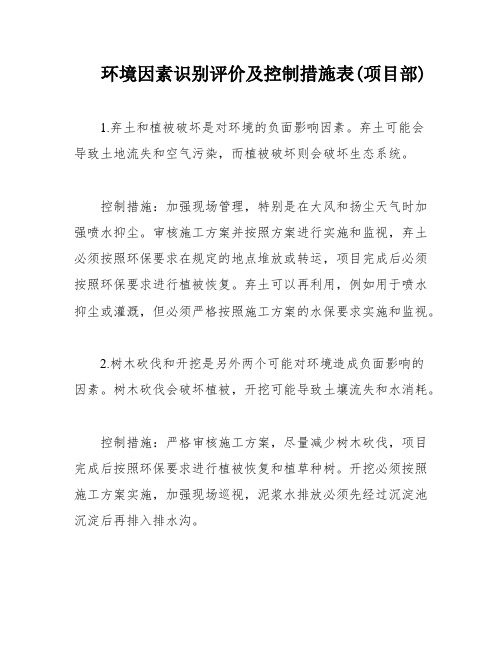
环境因素识别评价及控制措施表(项目部)
1.弃土和植被破坏是对环境的负面影响因素。
弃土可能会
导致土地流失和空气污染,而植被破坏则会破坏生态系统。
控制措施:加强现场管理,特别是在大风和扬尘天气时加强喷水抑尘。
审核施工方案并按照方案进行实施和监视,弃土必须按照环保要求在规定的地点堆放或转运,项目完成后必须按照环保要求进行植被恢复。
弃土可以再利用,例如用于喷水抑尘或灌溉,但必须严格按照施工方案的水保要求实施和监视。
2.树木砍伐和开挖是另外两个可能对环境造成负面影响的
因素。
树木砍伐会破坏植被,开挖可能导致土壤流失和水消耗。
控制措施:严格审核施工方案,尽量减少树木砍伐,项目完成后按照环保要求进行植被恢复和植草种树。
开挖必须按照施工方案实施,加强现场巡视,泥浆水排放必须先经过沉淀池沉淀后再排入排水沟。
3.噪声和能源消耗也可能对环境造成负面影响。
噪声排放
会污染空气,能源消耗则会浪费资源。
控制措施:严格审核施工方案,要求使用合格且经检验合格的施工机械,噪声、油耗、电耗、有害气体排放等必须达到国家相关规定与要求。
加强现场巡视和监督检查施工方环境保护措施的实施情况。
4.基础设施建设和混凝土搅拌也可能对环境造成负面影响。
基础设施建设可能会导致土地和空气污染,混凝土搅拌可能会污染空气和土地。
控制措施:严格按照施工方案实施,加强现场巡视和监督。
混凝土搅拌后的废水必须按照相关要求进行处理,例如排入沉淀池沉淀后再排入排水沟。
环境因素控制措施
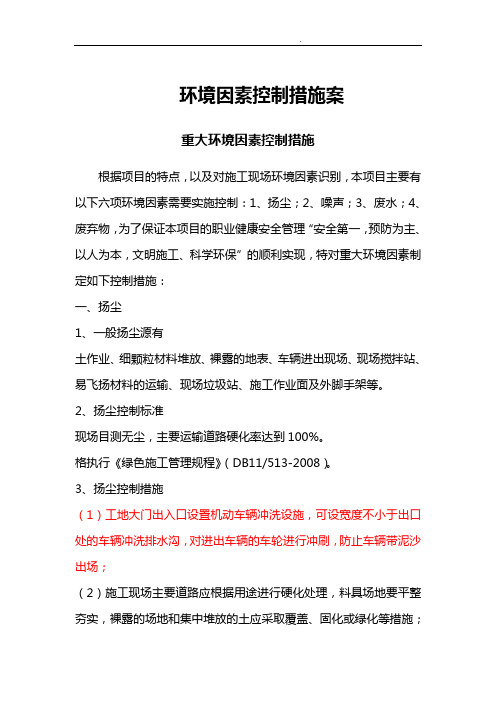
环境因素控制措施案重大环境因素控制措施根据项目的特点,以及对施工现场环境因素识别,本项目主要有以下六项环境因素需要实施控制:1、扬尘;2、噪声;3、废水;4、废弃物,为了保证本项目的职业健康安全管理“安全第一,预防为主、以人为本,文明施工、科学环保”的顺利实现,特对重大环境因素制定如下控制措施:一、扬尘1、一般扬尘源有土作业、细颗粒材料堆放、裸露的地表、车辆进出现场、现场搅拌站、易飞扬材料的运输、现场垃圾站、施工作业面及外脚手架等。
2、扬尘控制标准现场目测无尘,主要运输道路硬化率达到100%。
格执行《绿色施工管理规程》(DB11/513-2008)。
3、扬尘控制措施(1)工地大门出入口设置机动车辆冲洗设施,可设宽度不小于出口处的车辆冲洗排水沟,对进出车辆的车轮进行冲刷,防止车辆带泥沙出场;(2)施工现场主要道路应根据用途进行硬化处理,料具场地要平整夯实,裸露的场地和集中堆放的土应采取覆盖、固化或绿化等措施;施工现场的办公区和生活区进行绿化和美化;(3)现场料具存放整齐,易飞扬的细颗粒材料(白灰、粉煤灰、袋装水泥等)要入库或密封闭存放。
(4)施工现场建立封闭式垃圾站,按照规定及时清运消纳,禁随意抛撒。
建筑物施工垃圾的清运,必须采用相应容器或管道运输,禁凌空抛掷。
(5)本市中心城区(包括规划市区、回龙观和北苑北地区)、北京经济技术开发区、新城城关镇地区和其他区域所有政府投资建设工程,禁止现场搅拌砂浆(以下简称“禁现”)。
(6)现场土应集中堆放采取覆盖、固化或绿化洒水等措施,遇有四级以上大风天气停止土施工及其他可能产生扬尘污染的施工;(7)车辆运输砂、土、渣土和垃圾不得超量装载,装运土、砂的最高点不得超过槽帮上缘50公分,两侧边缘应低于槽帮上缘10至20公分;装运建筑渣土、垃圾不得超过槽帮上缘;运输车辆应密覆盖,并防止卸运和运输中的遗撒;(8)施工现场贯彻“工完场清”制度,施工完成后及时对施工作业面及外脚手架上的垃圾及杂物进行清理;高空施工的垃圾及废弃物采用密闭容器或其他措施清理搬运,禁止高空抛物;(9)施工现场使用预拌混凝土应按照北京市《关于本市建设工程中进一步禁止现场搅拌砂浆的通知》××文件的有关规定执行,对工程浇筑剩余的预拌混凝土要进行妥善再利用,禁随意丢弃。
建筑项目管理知识:建筑项目管理中的环境因素

建筑项目管理知识:建筑项目管理中的环境因素建筑项目管理是指通过计划、组织、控制和监督等手段,将建筑项目从规划、设计到建设、验收等整个过程中的各个环节加以管理和协调,使得建筑项目能够按时、按质、按量地完成,实现建筑项目的最大效益。
而在建筑项目管理中,环境因素是非常重要的一项考虑因素,本文将从以下几个方面来阐述建筑项目管理中环境因素的重要性。
一、环境因素对建筑项目进行规划的影响建筑项目的规划是一个非常重要的环节,规划的好坏直接关系到建筑项目最终的效益。
而环境因素对建筑项目的规划有着非常大的影响。
比如,在一些恶劣的环境中,比如地质条件不佳、气候恶劣等地方,建筑项目的规划需要更为谨慎,需要考虑环境对于建筑物的影响和相应的解决方案。
二、环境因素对建筑项目进度的影响环境因素也会对建筑项目的进度产生影响。
比如,在一些灾害频发或者地质条件恶劣的地方,施工困难,可能需要更长的时间才能完成。
这就需要制定合理的进度计划,以应对可能遇到的环境影响。
三、环境因素对建筑项目质量的影响建筑项目的质量是决定项目效益的重要因素,而环境因素也会对建筑物的质量产生影响。
比如,在污染严重的地区建筑物可能会受到钢筋锈蚀、混凝土老化等问题的影响,需要更为严格的质量要求和管控。
四、环境因素对建筑项目成本的影响环境因素也会对建筑项目的成本产生影响。
比如,在一些地区水泥、砂石等原材料价格较高,在这种情况下建筑项目的成本也会较高。
同时,在偏远地区或者气候恶劣的地方,施工难度较大,工人的生活费用也会增加,进而会对建筑项目的成本产生影响。
综上所述,环境因素在建筑项目管理中的作用非常重要,从规划、进度、质量到成本的各个方面都需要考虑环境因素的影响。
因此,在建筑项目管理的实际操作过程中,需要针对不同的环境条件,制定相应的计划和措施,最终确保建筑项目能够按时按质完成,实现最大效益。
建筑工地环境因素清单及重要因素要素

建筑工地环境因素清单及重要因素要素本文档旨在列举建筑工地中的环境因素清单,并介绍其中的重要因素要素。
建筑工地的环境因素对工地的运作和工人的健康安全有重要影响,因此需要进行合理的管理和控制。
环境因素清单以下是建筑工地中常见的环境因素清单:1. 噪音:建筑工地常常伴随着机械设备的运转和施工工人的活动,产生噪音。
噪音超过一定的限制值可能会对工人的听力造成损害,因此需要采取噪音控制措施。
2. 粉尘:建筑施工过程中会产生大量粉尘,对工人的呼吸系统和健康造成潜在威胁。
要采取适当的粉尘控制措施,包括湿式施工和粉尘防护设备的使用。
3. 振动:机械设备和施工活动产生的振动可能对周围建筑物和地下管道造成破坏,需要进行振动监测和控制。
4. 气味:某些施工材料和活动可能会产生难闻的气味,对周围居民造成困扰。
需要适当的通风和气味控制措施。
5. 光照:建筑工地中的光照条件对工人的安全和工作效率有影响。
需要确保工地的光照充足,同时也要避免光照强度过大对工人的眼睛造成伤害。
6. 水质:若建筑工地需要使用水源,需要保证水质达到安全标准,以防止对工人和周围环境造成污染。
重要因素要素以下是建筑工地中的重要环境因素要素:1. 安全措施:建筑工地的安全措施是最重要的环境因素要素之一。
包括安全防护设备的使用、培训工人的安全意识以及建立安全管理制度和应急预案。
2. 环保措施:为保护周围环境,建筑工地需要采取相应的环保措施。
包括对废弃物的妥善处理、合理使用能源和资源、减少污染物排放等。
3. 施工计划:合理的施工计划可以帮助减少环境因素对工地运作和工人的影响。
需要考虑环境因素对施工进度的影响,并制定相应的计划。
4. 监测和控制:建筑工地需要进行环境监测,及时掌握环境因素的变化,并采取相应的控制措施。
包括噪音、粉尘、振动等方面的监测和控制。
5. 公众参与:建筑工地所在地的居民和周边环境可能受到建筑工地的影响。
因此,公众参与是重要的环境因素要素之一。
环境因素和危险源管理制度

环境因素和危险源管理制度环境因素和危险源管理制度是指依据法律法规和相关标准,针对企业生产经营活动中可能出现的环境因素和危险源进行综合管理的一套制度体系。
其目的是确保企业生产经营活动的安全可持续发展,保护员工的生命安全和健康,避免对环境造成污染和破坏。
一、环境因素管理环境因素管理是指对企业生产活动所涉及的各种环境因素进行系统性的管理和控制。
环境因素包括但不限于空气质量、水源质量、土壤质量、噪声、辐射等。
1.环境影响评价。
企业在进行新项目建设或重大改造时,应进行环境影响评价,评估其对环境的潜在影响,制定相应的管理措施,确保项目对环境造成的影响不超出法律法规规定的限值。
2.环境监测与评估。
企业应建立环境监测与评估体系,定期对企业周边环境进行监测和评估,确保企业的生产活动符合环保要求,并及时采取相应的措施来改善和纠正。
3.环境管理措施。
企业应制定环境管理措施,包括但不限于废水、废气、固体废物等的排放控制和处理,以及节能减排措施等,确保企业的生产活动对环境影响最小化。
危险源管理制度是指对企业生产经营活动中存在的各种危险源进行识别、评估和控制的一套管理制度体系。
危险源包括但不限于化学品、机械设备、高温、高压等可能对人身安全造成伤害的因素。
1.危险源识别和评估。
企业应对可能存在的危险源进行全面识别和评估,包括对设备、工艺、场所等进行风险评估和等级划分,确保相关危险源能够得到有效控制。
2.安全生产规章制度。
企业应制定详细的安全生产规章制度,并向员工进行培训和宣传,确保员工具备相关的安全生产知识和技能,并能够严格遵守相关规章制度。
3.应急预案和演练。
企业应制定应急预案,针对可能发生的事故和突发事件制定相应的处置措施和应对方案,并定期进行应急演练,提高员工的应急处置能力。
4.安全设施和设备。
企业应配置和维护相关安全设施和设备,包括但不限于灭火器、防爆设备、排烟设备等,确保在发生事故时能够及时采取相应的措施,保障人身安全。
重要环境因素管理方案

重要环境因素管理方案1. 简介环境因素是指对一个项目或组织产生影响的外部要素,包括政治、经济、社会、技术、自然环境等。
在项目管理中,合理管理环境因素是项目成功的关键之一。
本文将介绍一个重要环境因素管理方案,帮助项目经理和团队有效应对环境变化,提升项目的成功率。
2. 环境因素的重要性环境因素在项目管理中扮演着重要的角色,对项目的进展和结果具有直接影响。
例如,政治稳定与变动、经济发展与衰退、社会需求与观念变化,都会对项目的可行性、资源投入和市场需求等方面产生重要影响。
同时,技术的进步、自然灾害等外部因素也会影响项目的进展与成功。
因此,合理管理环境因素是项目成功的关键所在。
3. 环境因素管理方案3.1 分析环境因素在项目启动阶段,项目经理需要对环境因素进行深入分析和评估。
这包括政治、经济、社会、技术和自然环境等方面。
项目经理可以使用SWOT分析法,即对项目进行优势、劣势、机会和威胁的分析,以确定项目的关键环境因素。
3.2 制定应对策略根据分析结果,项目经理需要制定相应的环境因素应对策略。
对于政治因素的影响,例如政策的变动,项目经理可以积极与相关政府部门建立合作关系,及时了解政策动向,并制定相应调整计划。
对于经济因素的影响,项目经理应定期关注市场变化,合理规划项目预算和资源投入。
对于社会因素的影响,项目经理可以通过开展市场调研和用户需求分析等方式,了解社会需求和观念变化,从而调整项目的目标和功能。
对于技术和自然环境因素,项目经理需紧密跟踪科技发展和自然灾害的可能影响,并预测和制定相应危机处理计划。
3.3 团队协作和沟通在项目执行过程中,项目团队需要紧密合作和沟通,共同应对环境因素的变化。
项目经理可以采用一些有效的沟通和协作工具,如会议、沟通平台等,及时传递环境变化信息,分享解决方案,并迅速做出调整。
同时,项目团队成员也应相互扶持和支持,共同应对环境因素的挑战。
3.4 监控和评估环境因素是一个动态的过程,需要项目经理时刻关注并及时调整管理策略。
项目部重要环境因素管理方案
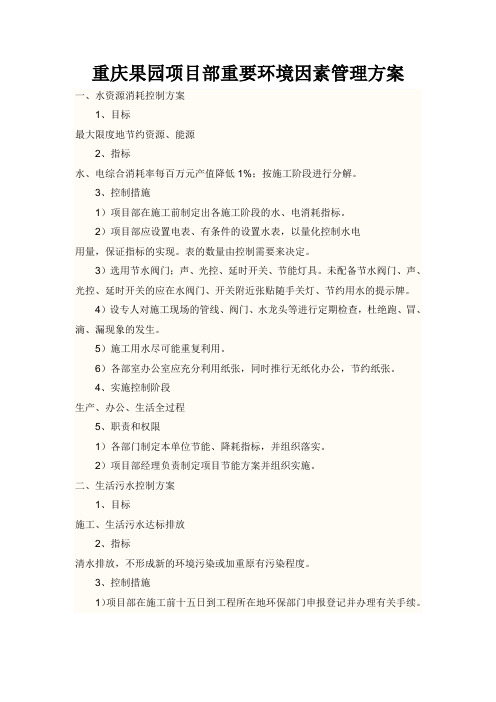
重庆果园项目部重要环境因素管理方案一、水资源消耗控制方案1、目标最大限度地节约资源、能源2、指标水、电综合消耗率每百万元产值降低1%;按施工阶段进行分解。
3、控制措施1)项目部在施工前制定出各施工阶段的水、电消耗指标。
2)项目部应设置电表、有条件的设置水表,以量化控制水电用量,保证指标的实现。
表的数量由控制需要来决定。
3)选用节水阀门;声、光控、延时开关、节能灯具。
未配备节水阀门、声、光控、延时开关的应在水阀门、开关附近张贴随手关灯、节约用水的提示牌。
4)设专人对施工现场的管线、阀门、水龙头等进行定期检查,杜绝跑、冒、滴、漏现象的发生。
5)施工用水尽可能重复利用。
6)各部室办公室应充分利用纸张,同时推行无纸化办公,节约纸张。
4、实施控制阶段生产、办公、生活全过程5、职责和权限1)各部门制定本单位节能、降耗指标,并组织落实。
2)项目部经理负责制定项目节能方案并组织实施。
二、生活污水控制方案1、目标施工、生活污水达标排放2、指标清水排放,不形成新的环境污染或加重原有污染程度。
3、控制措施1)项目部在施工前十五日到工程所在地环保部门申报登记并办理有关手续。
2)开工前,项目部要结合总平面图确定污水排向,并结合生产变化及时修改,直接排向水域的无毒污水,除达到清水排放外,还要主动向当地环保部门申报,并定期请环保部门监测,征求改进意见,保存记录。
3)对现场搅拌站和洗车池产生污水的处所设置沉淀池。
沉淀池的设置要符合相关的要求并设专人负责维护。
4)对有毒污水要单独处置,按规定进行合理处置或委托有资质能力处置的单位处置。
5)对生产污水进行有毒、无毒标识。
6)施工现场的食堂、浴池、厕所,在有排水管网的地区,要向当地有关部门申办《临时排水许可证》,实现污水集中排入管网。
在没有排水管网的地区,要自建管网集中排放。
7)食堂、浴池应设置隔油池、沉淀池,经过滤后实现清水排放。
过滤、沉淀物应按生活垃圾处理。
8)在有管网的地区,新建厕所一律为水冲式并设置化粪池,污水经过化粪池排放。
相关方环境因素辨识

相关方环境因素辨识在项目管理中,相关方是至关重要的因素,因为他们会受到项目的影响或会影响项目的进展。
了解并适当处理相关方的环境因素,对于项目成功的实现具有至关重要的作用。
相关方的环境因素可以是有利的,也可以是不利的。
正确地辨识和管理这些因素是确保项目成功实施的关键之一。
相关方的环境因素相关方的环境因素指的是与项目相关的内外部环境因素,包括政治、经济、社会、技术、法律、自然等各个方面。
以下是一些可能影响项目成功的环境因素:政治环境政治环境指的是政府对项目的立场和政策的影响。
政治不稳定、政府的决策变化等都可能对项目造成负面的影响。
经济环境经济环境包括宏观和微观经济因素,如物价、消费者信心、利率、汇率、通货膨胀等。
这些因素会影响项目的成本、收益和预算。
社会环境社会环境包括人口变化、文化价值观的改变、习俗和社会趋势的变化等因素。
这些因素可能导致难以预测的变化,会对项目的需求、期望和执行造成影响。
技术环境技术环境指的是现有技术、技术趋势、新技术和软硬件开发等方面的因素。
这些因素可能会对项目进度、可行性和实施造成影响。
法律环境法律环境包括法律规定、法规、标准和监督等方面的因素。
环保法、劳动法、商标法等可能会对项目的实施产生影响。
自然环境自然环境包括天气、地理、自然灾害等。
自然因素对于城市规划和农业项目特别重要。
对于建筑项目,例如,地理位置和气候可能会对建筑设计和施工过程带来影响。
相关方环境因素辨识环境因素辨识是关键的项目管理流程。
在项目启动之前,需要收集、维护和更新相关方的环境因素信息。
以下是环境因素辨识的主要步骤:收集环境因素信息首先需要识别那些可能会影响项目成功的因素。
信息收集可以通过各种方式,例如调查问卷、采访、文献阅读、竞争情报等。
初步评估因素对于已经收集到的信息需要进行初步的筛选和评估,以确定哪些因素在项目实施中是关键或不关键的。
确定关键因素和相关方对于初步评估后的因素需要进一步筛选分析,确定那些对项目的影响最大,需要重点考虑和管理的因素。
项目管理事业环境因素重要说明

事业环境因素:项目团队不能控制的,将对项目产生影响、限制或指令作用的各种条件。
标签:无法选择、无法回避、无法控制、如果不遵守会带来负面后果
常见:组织文化、结构和治理、软件、基础设施、法律限制、市场条件、政府或行业标准、商业数据库、员工能力
组织内部的事业环境因素:
u组织文化、结构和治理。例如,愿景、使命、价值观、信念、文化规范、领导风格、等级制度 和职权关系、组织风格、道德和行为规范。
u学术研究。例如,行业研究、出版物和标杆对照成果。
u政府或行业标准。例如,与产品、生产、环境、质量和工艺有关的监管机构条例和标准。
u财务考虑因素。例如,货币汇率、利率、通货膨胀率、关税和地理位置。
u物理环境要素。例如,工作环境、天气和制约因素。
u设施和资源的地理分布。例如,工厂位置、虚拟团队、共享系统和云计算。
u基础设施。例如,现有设施、设备、组织通讯渠道和信息技术硬件的可用性和功能。
u信息技术软件。例如,进度计划软件工具、配置管理系统、进入其他在线自动化系统的网络界 面和工作授权系统。
u资源可用性。例如,合同和采购制约因素、经批准的供应商和分包商以及合作协议。
u员工能力。例如,现有人力资源的专业知识、技能、胜任力和特定知识
组织外部的事业环境因素:u市场条件。例如ຫໍສະໝຸດ 竞争对手、市场份额、品牌认知度和商标。
u社会和文化影响与问题。例如,政治氛围、行为规范、道德和观念。
u法律限制。例如,与安全、数据保护、商业行为、雇佣和采购有关的国家或 地方法律法规。
u商业数据库。例如,标杆对照成果、标准化的成本估算数据、行业风险研究资料和风险数据库。
分析建筑工程项目管理的影响因素及相应措施

分析建筑工程项目管理的影响因素及相应措施建筑工程项目管理是确保建筑工程能够按时完成、质量优良、预算合理的重要手段。
在实践过程中,建筑工程项目管理面临许多的影响因素,如环境因素、法律政策、市场需求等等。
本文将分析建筑工程项目管理的影响因素及相应措施。
一、环境因素的影响及相应措施在建筑工程项目管理中,环境因素是一个不可忽视的因素。
首先,施工现场的环境对建筑物的施工速度、质量以及安全性都会产生影响。
其次,自然环境因素,如天气、气温等也会对施工进度产生影响。
此外,政治环境的不稳定、经济环境的波动等因素也会直接或间接地影响建筑工程项目的管理。
针对环境因素的影响,项目管理者需要采取相应的措施。
首先要成立一个环境信息监测系统。
这个系统会记录建筑工程施工过程中的环境条件,以更好地预测环境变化。
其次,建立环境事件应急处理机制,对突发环境事件进行应急处理。
例如,建筑工地实行防雾霾措施。
法律政策始终都是建筑工程项目管理的核心问题。
在中国,建设工程领域有着严格而繁杂的法律法规体系。
可供参考的主要制度有《中华人民共和国建筑法》、《建设工程质量管理条例》等等。
在项目实施过程中,负责管理的人员必须严格遵守相关法律法规和实施标准。
针对法律政策的影响,首先要做的是制定一份全面的法律规章制度清单。
清单可以包含建筑工程施工前期的规划许可、招投标、合同管理等方面的法律法规。
清单可以帮助管理人员更好地对法律规章形成准确的理解。
其次,提高全体员工的法律法规意识和培养相关法律法规知识。
当市场需求发生变化时,建筑工程项目管理群体必须充分地感知变化,研究其体系,并及时作出相应的调整。
市场需求的变化可能是由于市场竞争加剧、科技进步、消费者消费习惯、文化等等。
建筑工程施工单位要调整工作方式、减少管理成本,并加强自身核心技术的发展。
项目管理者必须密切关注市场经济变化,建立市场调研和分析机制,通过对市场数据的收集和分析,掌握市场标准变化趋势,及时调整自身发展战略。
浅析项目管理中的环境因素2700字

浅析项目管理中的环境因素2700字摘要:工程项目管理是以施工项目为管理对象,以项目经理责任制为中心,以合同为依据,按施工项目的内在规律,实现资源的优化配置和对各生产要素进行有效的计划、组织、指导、控制,取得最佳经济效益的过程。
影响工程项目的环境很多,只有根据工程特点和具体条件,应对影响质量的环境因素,采取有效的措施严加控制才能取得预计的经济效益。
关键词:建筑;项目施工;环境;影响因素在建筑生命周期的各个阶段,包括规划设计、施工建造、运营与维护、拆除阶段,都会对环境造成不同的影响。
但建筑对环境造成的危害主要是在施工阶段,当然,规划、运营和拆除阶段虽然也会造成不同程度的影响。
由于施工阶段是形成项目实体的阶段,牵涉的单位和人员多、工艺复杂,造成的环境影响也是最直接、最明显的。
近年来,我国城镇建设一直处于高速发展期,每年建成的房屋面积高达16×108m2~20×108m2,超过了所有发达国家年建成建筑面积的总和。
按照每新建1×104m2建筑排出垃圾约500t~600t 计算,近年我国全年仅施工建设产出和排放的建筑垃圾数量就在0.8×108t~1.2×108t之间。
在能源消耗方面,建筑物施工阶段能耗可以占到建筑物全生命周期内能耗的23%,在低能耗建筑中甚至高达40%~60%。
除了大量的建筑垃圾,能源消耗和浪费外,施工阶段对环境的影响还包括噪声污染;大气污染、水污染、光污染、土地资源污染和浪费等。
一、项目施工阶段对环境的主要影响因素1、噪音污染根据《中华人民共和国噪声污染防治法》规定;建筑施工噪声是指在建筑施工过程中产生的干扰周围生活环境的声音。
建筑施工噪声是指建筑工地现场产生的环境噪声,主要是由施工机械产生的,此外还有脚手架装卸、安装与拆除;模板支拆、清理、修复、切割等工作噪声。
由于建筑施工机械产生的噪声一般均超过国家施工场界声限值的标准,所以施工噪声影响人体健康和社区居民休息的重要污染源之一。
- 1、下载文档前请自行甄别文档内容的完整性,平台不提供额外的编辑、内容补充、找答案等附加服务。
- 2、"仅部分预览"的文档,不可在线预览部分如存在完整性等问题,可反馈申请退款(可完整预览的文档不适用该条件!)。
- 3、如文档侵犯您的权益,请联系客服反馈,我们会尽快为您处理(人工客服工作时间:9:00-18:30)。
Source: pmbok guide 2000
.
2-3
Phase Characteristics
• Deliverables • Reviews Tangible, verifiable work products Evaluation of deliverables and project performance • Phase Exit Criteria Measurements used to determine if project should go into next phase
• Shared values, norms, beliefs, and expectations
• Reflected in policies and procedures, view of authority relationships, etc. • Directly influences the project
Source: pmbok guide 2000
.
2-4
Characteristics of Life Cycle
• Defines the beginning and end of the project • Deliverables usually approved before work starts on the next phase • Sometimes a subsequent phase is begun prior to approval of the previous phase. This is called fast tracking.
Source: pmbok guide 2000 . 2-2
Project Life Cycle
• Defines the beginning and end of the project
• Divides the project into phases that provide better management control and the appropriate links to the ongoing operations of the organization
– Non-Project-based
• No project-oriented systems in place to support project needs efficiently and effectively
Source: pmbok guide 2000 . 2-9
Organizational Cultures & Styles
. 2-8
Organizational Influences
• Organizational systems
– Project-based
• Derive income by performing projects for others • Treat on-going operations as projects (management by projects)
Key Stakeholders • Project manager • Customer • Performing organization • Sponsor
Source: pmbok guide 2000
Manages the project Uses the product or service Enterprise that does the project work Provides financial resources
• Matrix organization – Blend of both
Source: pmbok guide 2000 . 2-11
Organizational Structure
• Project Office
– Provides services ranging from support functions to project managers, such as training, software, templates, etc. to actually being responsible for the results of the project
Weak Matrix Strong Matrix Projectized
Low
Low –> Medium Medium –> High High
Source: pmbok guide 2000
.
2-17
General Management Skills
• Leading
– Establishing direction, aligning people, motivating, and inspiring
Source: pmbok guide 2000 . 2-6
Phases and Resources Usage
• • • •
Concept Development Impl15%
. 2-7
Source: pmbok guide 2000
Project Stakeholders
Individuals and organizations who are actively involved in the project and whose interests may be positively or negatively affected by the project success or failure
• Functional emphasis – loyalties may impede completion
Source: pmbok guide 2000
.
2-13
Organizational Planning
Matrix Organization
• Multiple-command system
• Defines technical work and implementers
Source: pmbok guide 2000 . 2-5
Characteristics of Life Cycle
(cont.)
• Cost and staffing levels are low at the start, higher towards the end, and drop as project closes • Probability of project success is low at the start of the project and gets progressively higher as the project continues • Cost of changes and of error correction generally increases as the project continues
Source: pmbok guide 2000
.
2-14
Organizational Planning
Matrix Organization
• Advantages
– – – – – Visible objectives Efficient utilization of resources Better co-ordination Better information flow Retention of home after project
. 2-15
Organizational Planning
Projectized Organization
• Emerges from functional when latter impedes progress
• Line of authority is the PM • Uncertainty where to go on completion of project • Tendency to retain assigned personnel too long • FMs feel threatened as people are removed from their areas
Source: pmbok guide 2000
.
2-12
Organizational Planning
Functional Organization
• Specialists grouped by function
• Difficult to cross functional lines
• Barriers exist on horizontal information flow
Source: pmbok guide 2000
.
2-10
Organizational Structure
• Functional organization – Hierarchy where each employee has one clear superior
• Projectized organization – Most of organization’s resources are involved in project work and report to the project manager
PMP Preparation Training
云志网络
Project Management Environment
Chapter 2
Objectives
• To be able to describe:
– – – – Project life cycle Characteristics of the project phases Key project stakeholders Organizational and socioeconomic influences on the project – Key management skills used in managing a project
